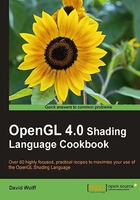
Introduction
Shaders were first introduced into OpenGL in version 2.0, introducing programmability into the formerly fixed-function OpenGL pipeline. Shaders give us the power to implement alternative rendering algorithms and a greater degree of flexibility in the implementation of those techniques. With shaders, we can run custom code directly on the GPU, providing us with the opportunity to leverage the high degree of parallelism available with modern GPUs.
Shaders are implemented using the OpenGL Shading Language (GLSL). The GLSL is syntactically similar to C, which should make it easier for experienced OpenGL programmers to learn. Due to the nature of this text, I won't present a thorough introduction to GLSL here. Instead, if you're new to GLSL, reading through these recipes should help you to learn the language by example. If you are already comfortable with GLSL, but don't have experience with version 4.0, you'll see how to implement these techniques utilizing the newer API. However, before we jump into GLSL programming, let's take a quick look at how vertex and fragment shaders fit within the OpenGL pipeline.
Vertex and fragment shaders
In OpenGL version 4.0, there are five shader stages: vertex, geometry, tessellation control, tessellation evaluation, and fragment. In this chapter we'll focus only on the vertex and fragment stages. In Chapter 6, I'll provide some recipes for working with the geometry and tessellation shaders.
Shaders replace parts of the OpenGL pipeline. More specifically, they make those parts of the pipeline programmable. The following block diagram shows a simplified view of the OpenGL pipeline with only the vertex and fragment shaders installed.

Vertex data is sent down the pipeline and arrives at the vertex shader via shader input variables. The vertex shader's input variables correspond to vertex attributes (see Chapter 1, Sending data to a shader using per-vertex attributes and vertex buffer objects). In general, a shader receives its input via programmer-defined input variables, and the data for those variables comes either from the main OpenGL application or previous pipeline stages (other shaders). For example, a fragment shader's input variables might be fed from the output variables of the vertex shader. Data can also be provided to any shader stage using uniform variables (see Chapter 1: Sending data to a shader using uniform variables). These are used for information that changes less often than vertex attributes (for example, matrices, light position, and other settings). The following figure shows a simplified view of the relationships between input and output variables when there are two shaders active (vertex and fragment).

The vertex shader is executed once for each vertex, possibly in parallel. The data corresponding to vertex position must be transformed into clip coordinates and assigned to the output variable gl_Position before the vertex shader finishes execution. The vertex shader can send other information down the pipeline using shader output variables. For example, the vertex shader might also compute the color associated with the vertex. That color would be passed to later stages via an appropriate output variable.
Between the vertex and fragment shader, the vertices are assembled into primitives, clipping takes place, and the viewport transformation is applied (among other operations). The rasterization process then takes place and the polygon is filled (if necessary). The fragment shader is executed once for each fragment (pixel) of the polygon being rendered (typically in parallel). Data provided from the vertex shader is (by default) interpolated in a perspective correct manner, and provided to the fragment shader via shader input variables. The fragment shader determines the appropriate color for the pixel and sends it to the frame buffer using output variables. The depth information is handled automatically.
Replicating the old fixed functionality
Programmable shaders give us tremendous power and flexibility. However, in some cases we might just want to re-implement the basic shading techniques that were used in the default fixed-function pipeline, or perhaps use them as a basis for other shading techniques. Studying the basic shading algorithm of the old fixed-function pipeline can also be a good way to get started when learning about shader programming.
In this chapter, we'll look at the basic techniques for implementing shading similar to that of the old fixed-function pipeline. We'll cover the standard ambient, diffuse, and specular (ADS) shading algorithm, the implementation of two-sided rendering, and flat shading. Along the way, we'll also see some examples of other GLSL features such as functions, subroutines, and the discard keyword.
The algorithms presented within this chapter are largely unoptimized. I present them this way to avoid additional confusion for someone who is learning the techniques for the first time. We'll look at a few optimization techniques at the end of some recipes, and some more in the next chapter.